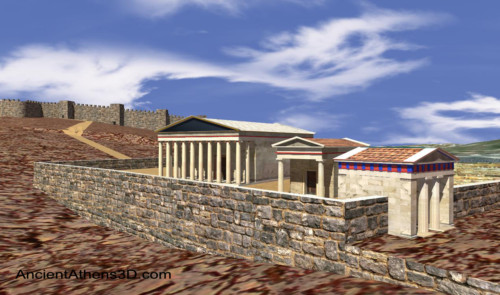The sanctuary and the temple of Athena Sounias
Almost 500 metres northeast of Poseidon’s Sanctuary there was the Sanctuary of Athena Sounias. This Sanctuary was consisted of an enclosure, surrounding Athena’s temple, and another smaller temple. One small circular enclosure was incorporated in the bigger one. The Sanctuary was accessible from the north, through a monumental Propylon (entrance).
The temple of Athena Sounias
The Temple of Athena Sounias was a very unusual and peculiar structure. It was an Ionic temple with a rectangular cella, surrounded by a colonnade covering only on the south and east of the building. The reason for this is not clear. Probably the plan of the temple was so from the beginning. If not, the colonnade was added shortly after construction and had this format for practical and aesthetic reasons.
The temple is generally characterized by simplicity. There was no sculptural decoration and colors were probably limited to the cornices and the clay sima. Inside there was a colossal statue whose base survives today. The dimensions of the temple were 16.4 × 11.6 m and in the middle of the cella there were the four columns which supported the roof. In Roman times the temple had been abandoned and thus, the outer colonnade was transferred and used anew in a building in the Agora of Athens.
The sanctuary of Athena Sounias from the northeast. The walls sourrounding the sanctuary of Poseidon are visible in the background.






